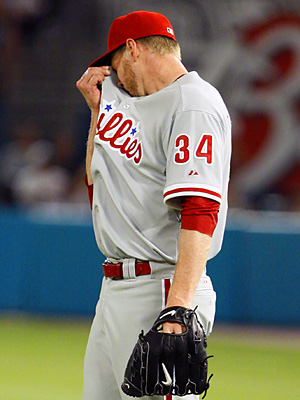Yes, Halladay was perfect, but he has actually pitched better games
From those depths Halladay has become perhaps the best pitcher in baseball. On a Saturday night in Miami, he became a legend. Halladay is just the 20th pitcher in baseball history to throw a perfect game, retiring 27 consecutive Marlins, striking out 11 of them and pitching the Phillies to a 1-0 win. Just six days after taking his worst beating as a Phillie, Halladay joined the Athletics' Dallas Braden as the second hurler this month to have the ultimate start.
What's striking about Doc's achievement is that he has almost certainly pitched better, even this season, than he did last night. Halladay wasn't quite his usual strike-throwing, grounder-inducing self. In a year in which 68 percent of his pitches have been in the zone, just 63 percent were Saturday night. He had seven three-ball counts, after having just 44 in his first 10 starts. Halladay worked from behind on half the hitters, something he usually does about a third of the time. A ground-ball machine, allowing fly balls on less than a quarter of balls in play, Halladay allowed a number of deep flies and one hard-hit liner to center. A pitcher whose location is almost never an issue hung breaking balls late in the game to Gaby Sanchez and Cody Ross, neither of whom could make Halladay pay for the mistake.
From release to the ball crossing the plate, Halladay has pitched better than he did Saturday night. His shutout of the Braves on April 21 was more impressive, and arguably his shutout of the Mets or complete game over the Astros just as impressive. On Saturday night he had exceptional movement in and out of the zone, however, which is one reason why he induced so many strikeouts (11). The Marlins seemed to be one pitch behind the entire night, taking six called third strikes, never seeming to have any idea where the next delivery would end up. That movement kept Florida's hitters so out of sync that they couldn't take advantage of Halladay's occasional mistakes, such as the hangers to Sanchez in the seventh and Ross in the eighth. It was why the Marlins never came that close to a hit; a grounder to the 5-6 hole in the sixth by Cameron Maybin was as near as they got. There was no DeWayne Wise moment, no Rusty Greer dive, no 12-pitch at-bat to build drama and create hope. There was just out after out after out, 27 of them, lining the path to immortality.
This is who Roy Halladay is now. Ten years after making the wrong kind of history, he's reached a level at which he can throw a perfect game without being at his very best. He can go 27 up, 27 down without creating a signature highlight for his teammates. He can join a select group of pitchers without it being a particularly special night for him. When Dallas Braden threw his perfect game, you knew you were watching something rare, the greatest moment of what will likely be an ordinary career. With Halladay, you can argue that he has looked better this month. You find yourself looking at the schedule and wondering if you can make it down to Philadelphia on Friday, because the Padres are in town, and they don't have a very impressive lineup ...
Ten years ago, Roy Halladay had to wonder if he'd ever get to make consecutive starts again. Now, we wonder if he can throw consecutive no-hitters.
• Ranking perfect games is a silly exercise, but let's reserve some respect for the fact that Halladay was protecting a 1-0 lead for the last seven innings. The last pitcher to throw a perfect game without any kind of cushion was Tom Browning, who beat the Dodgers 1-0 on Sept. 16, 1988. Before that, Mike Witt beat the Rangers 1-0 on the last day of the 1984 season. All I'll say about that game is that knuckleballer Charlie Hough also went the distance and walked just three batters in a game that ran 1:49.
• I was asked on Twitter about Fredi Gonzalez's pinch-hitters in the ninth inning. I don't mind using pinch-hitters there, but given the players involved, I would have made different decisions. Mike Lamb for Brett Hayes is a good call, getting the lefty OBP guy -- well, Mike Lamb was an OBP guy nine years ago or whenever he last played -- up to start the inning is optimal. After that, though, I'm not sure I buy hitting Wes Helms for Cameron Maybin, not when it means Ronnie Paulino will be batting for the pitcher. Paulino has a massive platoon split that has been persistent throughout his career, so I'd rather save Helms for the pitcher's slot, with whatever tradeoff exists at the plate in having Maybin hit instead of Paulino being made up for by having Maybin's speed in play should he reach base. So I would have gone Lamb/Maybin/Helms. It's a small thing, but I think it would have given the Marlins a slightly better chance to tie the game.
Check out Joe Sheehan's blog and subscribe to his newsletter here.





